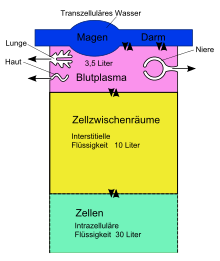Water balance (living beings)
In biology, the water balance describes the absorption and release of water in biological systems, such as cells , tissues or living beings as a whole.
Biological water balance
Water is the main component of living cells . It not only serves as a universal solvent , but is also produced in the cell metabolism and required as a substrate in photosynthesis . The water balance is therefore a central problem for living cells. Basically, plants have somewhat different mechanisms for regulating their water balance than animals and humans.
Water balance of plants
Water balance in animals
In water-dwelling animals, the water balance is coupled with the regulation of the salt content in the tissues. Here zoologists differentiate between two different strategies: osmoconformers and osmoregulators. Osmoconform animals are isotonic to the surrounding sea water. They are often unable to actively influence the salinity ( osmolarity ) of their tissue water. These marine organisms include the unicellular organisms and many invertebrates , such as. B. snails. Osmoregulators, on the other hand, have body fluids that are not isotonic to the surrounding water. You can actively influence their osmolarity. This is linked to the presence of excretory organs such as kidneys and nephridia , such as those already possessed by annelids and crabs . In bony fish , the excess salt is also released into the surrounding water via the gills . Osmoregulators need part of their metabolic energy for osmoregulation. This is the price for the functional reliability of the cell metabolism , the muscles , the senses and nerves .
Land-dwelling animals have other problems with their water balance: Depending on their habitat and climatic conditions, they are either threatened with dehydration and thus death, or their reproduction is restricted if this again takes place in the water. As with plants, evolution has developed a wealth of mechanisms for this. This includes an evaporation-inhibiting body surface with fur , plumage , scales or horn plates . In addition, various water recovery systems to limit the moisture in the exhaled air , the water in the urine or in the feces .
In this sense, the example of the Australian kangaroo rats is known , who do not have to drink for months because they can cover their water balance almost entirely from the oxidation water of glucose and fat respiration .
Water balance in humans

The water content of the human body can vary considerably depending on your personal constitution. In underweight people, it is up to 70% of body weight, while overweight people only contain 45% water. So the greater the amount of body fat , the lower it is. The reason is that the fat is the most variable part of the body, but at the same time it is the component that has the least amount of water.
The body absorbs water through beverages, through the water contained in food and through oxidized water from the combustion of nutrients.
The export of water from the body takes place via urine, feces, via the skin (as sweat and through transepidermal water loss ) and via the airways. This release of water is essential because metabolic products such as urea and salts are excreted with it, but heat can also be released from the core of the body at high outside temperatures.
For an adult man, one reckons with a minimum water release of around 1.5 liters per day (of which just under 1 liter through breathing and evaporation from the skin), which must be compensated for by an appropriate water intake. On average he needs about 2 liters a day.
Body fluid is located in the cells, i.e. intracellularly , but also outside the cells in the blood and in the intercellular spaces, i.e. extracellular and transcellular , that is, separated from the blood by epithelial layers . These include the fluids in the stomach and intestines , in the gallbladder in the large cavities of the body , the joint lubricant and the cerebrospinal fluid .
If increased water loss through sweat or diarrhea is not quickly replaced, the osmotic value, the osmolarity in the extracellular area, increases. Conversely, increased water intake leads to a decrease in the osmotic value. Normally, however, a healthy organism quickly compensates for such short-term deviations through changes in the water excretion via the kidneys . The antidiuretic hormone and its effect on the kidneys play an important role in this regulation .
literature
- Rüdiger Wehner , Walter Gehring : Zoology. 24th completely revised edition. Thieme Verlag, Stuttgart et al. 2007, ISBN 978-3-13-367424-9 .
- William K. Purves, David Sadava, Gordon H. Orians, H. Craig Heller: Biology. 7th edition. Spectrum Akademischer Verlag, Heidelberg 2006, ISBN 3-8274-1630-2 .
- Klaus D. Mörike, Eberhard Betz, Walter Mergenthaler: Human biology. 15th edition, corrected reprint of the 14th revised and updated edition. Quelle & Meyer, Wiebelsheim 2001, ISBN 3-494-01297-0 .
Individual evidence
- ↑ The daily release of water vapor by a physically inactive person is around 850 - 1000 g at an ambient temperature of 20 ° C according to VDI guideline 2078; quoted in: Klaus Usemann, Horst Gralle: Bauphysik: Problems, tasks and solutions , p. 18, Springer Verlag; accessed in January 2017